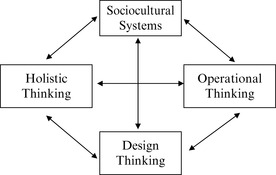Introduction
During the last 50 years, our worldview has gone through a profound transformation in two critical dimensions. Not only has there been a fundamental shift in our understanding of the nature of the organization from a mindless mechanical system to a purposeful sociocultural system, but there has also been a discriminating shift in our way of knowing from analytical thinking, the science of dealing with independent sets of variables, to systems thinking, the art and science of handling interdependent sets of variables.
Unfortunately, despite all the rhetoric to the contrary, our newly found insights have had very little influence on our choices. A dominant analytical culture, with a scientific tag, keeps reproducing the same set of non-solutions all over again. Effective use of these discriminating conceptions requires both a clear understanding of the operating principles of sociocultural systems and unambiguous recognition of the shortcomings of the analytical approach.
Years of struggle and real-life experimentation with different systems at different levels and in different cultures have led me to believe that the interactions among the following four foundations of systems thinking are the keys for development of an effective systems methodology as a complement and not a replacement for analytical thinking. The four foundations include: sociocultural systems, holistic thinking, operational thinking, and design thinking.
These four foundations, in my experience, are so interrelated and complementary that all four are necessary to effectively deal with the complexities of emerging chaotic environments. Both Ackoff's Interactive Design (1974) and Forrester's Systems Dynamics (1961) are part of this comprehensive scheme that also includes an in-depth understanding of the nature of sociocultural systems and the operational meaning of holistic thinking.
We see the world as increasingly more complex and chaotic because we use inadequate concepts to explain it. When we understand something, we no longer see it as chaotic or complex. An effective systems methodology would deal not only with the imperative of interdependency and the complexities of dynamic systems, but also with the question of purposeful behavior of multi-minded systems. As we saw in Chapter 3, unless we understand the implications of self-organizing behavior of sociocultural systems, the multi-minded beast will outmaneuver any attempt to tame it.
Part Two of this book contained a full discussion of the first foundation of systems thinking, the sociocultural system. In Part Three, we will deal with the three remaining foundations, holistic thinking, operational thinking, and design thinking, in 5, 6, 7, 8 and 9.
This version of systems methodology (interaction of the above-mentioned four foundations) is intended to create a holistic operational language of interaction and design. It is a way to see through chaos and understand complexities and face the dilemma of systems where the whole is becoming more and more interdependent while the parts display choice and behave independently. These are critical needs of policy makers, leaders, and many others who wrestle daily with how to improve organizations at all levels so that they contribute something of worth to their members and to the communities and clientele they serve. Far from being abstract and esoteric, the four foundations of systems methodology comprise a set of thinking tools that are enormously practical.
We will attempt to explicitly and operationally define systems methodology as we practice it at INTERACT, The Institute for Interactive Management. Although this practice has its origin in the rich and colorful tradition of Ackoff, in its present form, it has also been influenced greatly by the works of Jay Forrester, Kenneth Boulding, and Stafford Beer, and my own fascination with the complexities and engaging potency of the phenomenon known as culture. The depth and beauty of interactive design and the magic of holistic thinking (iteration of structure, function, and process) when combined with the power of systems dynamics, create a competent and exciting methodology that goes a long way in dealing with the emerging challenges of our time by responding to the operating principles of openness, purposefulness, multidimensionality, emergent property, and counterintuitive behavior of sociocultural systems.
..................Content has been hidden....................
You can't read the all page of ebook, please click here login for view all page.

